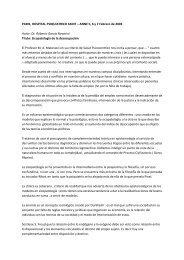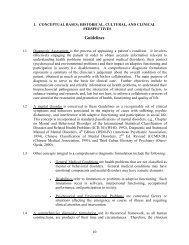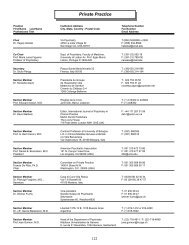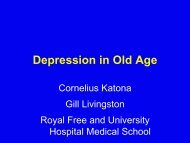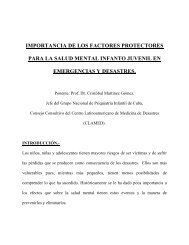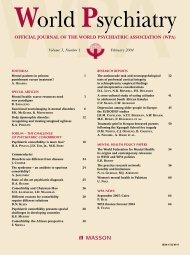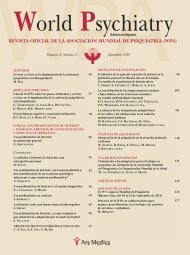ABSTRACTS - World Psychiatric Association
ABSTRACTS - World Psychiatric Association
ABSTRACTS - World Psychiatric Association
Create successful ePaper yourself
Turn your PDF publications into a flip-book with our unique Google optimized e-Paper software.
Health Organization has recently released global recommendations<br />
and guidelines on task shifting for scaling up HIV care and proposes<br />
the “adoption or expansion of a task shifting approach as one method<br />
of strengthening and expanding the health workforce to rapidly<br />
increase access to HIV and other health services”. The scarcity of specialist<br />
mental health human resources in developing countries, compounded<br />
by their inequitable distribution and inefficient utilization,<br />
has been well documented. This human resource gap will remain<br />
large for the foreseeable future, and is likely to be worsened as populations<br />
grow in many countries and as specialists emigrate. We present<br />
a perspective on the role of task shifting to scale up mental health<br />
care, by empowering community and primary health workers to<br />
deliver specific tasks, the evidence base which supports the effectiveness<br />
of task shifting interventions in mental health care, the role of<br />
mental health specialists in such intervention programs, and future<br />
research and program opportunities.<br />
US15.3.<br />
THE INTERFACE BETWEEN PRIMARY CARE<br />
AND SPECIALIZED MENTAL HEALTH SERVICES:<br />
IS IT LOSING IMPETUS<br />
R. Araya<br />
University of Bristol, UK<br />
There was great interest in the 1980s and 1990s to propose and test a<br />
variety of working models for the interface between primary care and<br />
mental health services. There is some evidence to suggest that gradually<br />
this interest may have diminished. Some reasons that may explain<br />
this situation include the preferential attention given to research and<br />
development on models to improve the resolution of selected priority<br />
health problems in primary care or the difficulties to break the existing<br />
formal and informal boundaries between primary care and psychiatry.<br />
The situation is rather different in countries with different levels<br />
of development. In some low-income countries there are few psychiatrists<br />
but there are other forms of specialized mental health services.<br />
Unsurprisingly in those countries psychiatrists may not be at the<br />
centre of this interface. In other more resourceful middle-income<br />
countries with a reasonable number of psychiatrists, other members<br />
of the team – often psychologists – play a much more active role in<br />
this interface. In some high-income countries, some people have<br />
argued that perhaps the central role of the psychiatrist in this interface<br />
should be scrutinized more carefully. Several successful experiences<br />
with nurse specialists and psychologists are worth a more careful<br />
evaluation. There is some evidence to suggest that some treatment<br />
practices deeply established in developed countries may have little<br />
empirical support for their existence. Some have argued that disinvesting<br />
in some of these costly practices may be an option.<br />
US16.<br />
EFFECTIVENESS AND COST-EFFECTIVENESS<br />
OF PHARMACOLOGICAL TREATMENTS<br />
IN PSYCHIATRY: EVIDENCE FROM PRAGMATIC<br />
TRIALS<br />
US16.1.<br />
UTILIZING THE RESULTS OF PRACTICAL CLINICAL<br />
TRIALS TO OPTIMIZE TREATMENT FOR INDIVIDUAL<br />
PATIENTS<br />
J.A. Lieberman<br />
Columbia University College of Physicians and Surgeons,<br />
New York State <strong>Psychiatric</strong> Institute, New York, NY, USA<br />
There is a saying that doctors should “use a new treatment fast while<br />
it still works”. This is because clinicians have grown accustomed to<br />
the fact that new drugs are approved based on their testing in rigorous<br />
clinical trials with great fanfare and high expectations, which they<br />
rarely live up to when used in routine clinical settings. This disconnect<br />
reflects the so-called “efficacy-effectiveness gap”. This gap refers to the<br />
reasons why the results of randomized clinical trials designed largely<br />
to gain regulatory approval for new drugs or additional indications for<br />
the marketed drugs do not accurately reflect how drugs work when<br />
they are applied to broad patient populations in real world settings<br />
and can best be filled by the conduct of practical clinical trials which<br />
aim to determine treatment effectiveness in representative patient<br />
populations in ecologically valid clinical settings. Consequently, there<br />
is an increasing recognition of the urgent need for more practical clinical<br />
trials that will evaluate the comparative effectiveness of currently<br />
marketed treatments, so that we know how best to utilize them and<br />
whether they justify their cost. This paper describes the role of the various<br />
types of studies in the course of drug development and then<br />
emphasizes the unique features and information that practical trials<br />
can provide. In this context the recently published CATIE, CUTLASS,<br />
EUFEST and TEOSS trials are reviewed and analyzed.<br />
US16.2.<br />
EFFECTIVENESS OF SECOND-GENERATION<br />
ANTIPSYCHOTICS IN FIRST EPISODE<br />
SCHIZOPHRENIA: THE EUFEST STUDY<br />
R.S. Kahn<br />
Department of Psychiatry, Rudolf Magnus Institute<br />
of Neuroscience, University Medical Centre Utrecht,<br />
The Netherlands<br />
Second-generation antipsychotic drugs were introduced over a decade<br />
ago for the treatment of schizophrenia; however, their purported clinical<br />
effectiveness compared with first-generation antipsychotic drugs is<br />
still debated. We aimed to compare the effectiveness of second-generation<br />
antipsychotic drugs with that of a low dose of haloperidol, in firstepisode<br />
schizophrenia. We did an open randomised controlled trial of<br />
haloperidol vs. second-generation antipsychotic drugs in 50 sites, in 14<br />
countries. Eligible patients were aged 18-40 years, and met diagnostic<br />
criteria for schizophrenia, schizophreniform disorder, or schizoaffective<br />
disorder. 498 patients were randomly assigned by a web-based<br />
online system to haloperidol (1-4 mg/day; n=103), amisulpride (200-<br />
800 mg/day; n=104), olanzapine (5-20 mg/day; n=105), quetiapine<br />
(200-750 mg/day; n=104), or ziprasidone (40-160 mg/day; n=82). Follow-up<br />
was at one year. The primary outcome measure was all-cause<br />
treatment discontinuation. Patients and their treating physicians were<br />
not blinded to the assigned treatment. Analysis was by intention to<br />
treat. The number of patients who discontinued treatment for any<br />
19




